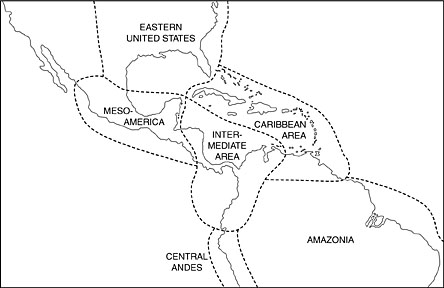

 | Page 262 |  |
Other museums founded at the time concentrated on culture rather than nature. Some, such as the Museo Montané at the University of Havana, were modeled after the present Musée de l’Homme in Paris, which covers the whole range of the discipline of anthropology, including artifacts obtained through ethnological study of contemporary peoples as well as archaeological research. Still other museums preferred to approach the artifacts from the standpoint of the disciplines of history and art; the Departmental Museum in Fort-de-France, Martinique, is an example.

Map 2. The Caribbean Culture Area and Its Neighboring Areas
(after Rouse 1964, Fig. 2)
Educational institutions have been slower to engage in the collection and exhibition of human remains. Toward the close of the nineteenth century Luis Montané, a Cuban who had studied at the Sorbonne in Paris, founded a Department of Anthropology at the University of Havana and initiated an extensive program of local research that resulted in the establishment of the museum that bears his name.
When the United States acquired Puerto Rico from Spain in 1898, its Smithsonian Institution asked J. Walter Fewkes, a staff member of the now-defunct subsidiary known as the Bureau of American Ethnology, to assess the anthropological resources of the nation’s new possession. Fewkes (1907) published a large volume summarizing current knowledge of the ethnology and archaeology of Puerto Rico and the neighboring islands.
In 1911, George G. Heye of New York City invited Fewkes to write a companion volume on the West Indian artifacts in his privately owned Museum of the American Indian, Heye Foundation (Fewkes 1922). Heye subsequently hired excavators such as Theodoor de Booy (1919) and Mark R. Harrington (1921) to expand his museum’s collections. The scientific value of their research was lessened by the fact that Heye insisted upon personally cataloging the finds only by site and not also recording the assemblages within the sites from which they had come. The Smithsonian Institution took over
 |  |